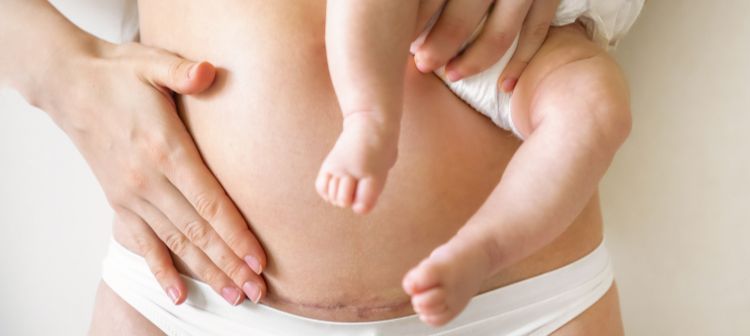Approximately one in four women in the UK will deliver by caesarean section. Whether planned or due to complications during delivery, a C-section is now a normal part of the birthing experience for many women.
Although a C-section is a relatively safe and straightforward procedure, it is not without risk and potential health complications both at the time of birth and later. There are also several lasting physical changes which can cause ongoing distress and discomfort. To mark Caesarean Awareness Month, we look at the surgical procedures designed to address the physical implications of a c-section.
C-section pouch removal
A caesarean section means cutting through the dermis, hypodermis and muscles to deliver the baby. The resulting scar can become anchored down to the core abdominal muscles and, as a result, a pooch or bulging belly of extra skin and fat gathers just above the incision line. This is often referred to as a C-shelf, C-overhang or C-section pouch.
Diet, exercise, and non-surgical procedures cannot improve the appearance of a C-section pouch. Surgical repair entails cutting along the original incision and releasing the adhesions between the subcutaneous fat and the abdominal wall muscle, producing an improved scar. The optimal approach is a tummy tuck or abdominoplasty that involves a new, lower incision, tightening of the abdominal muscles, and removal of any excess skin and fat.
Diastasis recti repair
For many years, it was believed that a C-section reduced the risk of many common post-partum complications, but a 2020 US study found that it is one of the most critical factors in negatively affecting the abdominal muscles. In particular, it can worsen and even cause diastasis recti.
During pregnancy, the connective tissue running down the midline of the abdominal wall expands to accommodate the growing baby. Nearly 60% of women are diagnosed with diastasis recti or abdominal separation after childbirth, and it is estimated that for 40% of those women, the muscles fail to move back into position.
For these women, an abdominal bulge develops and a resulting protruding belly that cannot be improved with diet or exercise. They can also experience core muscle weakness, lower back pain, difficulty with getting up or lifting and even urinary incontinence.
Some research has suggested that diastasis recti is more common in women who have given birth by c-section, as the nature of the recovery and process of healing around the incision site can weaken core function.
During diastasis recti repair, the separated muscles are stitched back together, which reduces the appearance of a pooch. Tightening of the abdominal muscles is performed as part of a standard tummy tuck or abdominoplasty if required.
Abdominoplasty or tummy tuck
Performed under a general anaesthetic, an abdominoplasty or tummy tuck is the gold standard surgical procedure for recontouring the abdominal area. Your Karidis Clinic surgeon will make a long incision just above the pubic area and access the length of the abdominal wall. Separated muscles are tightened, and excess skin and fat are removed. If required, your belly button will be repositioned.
Liposuction
If you still have good skin elasticity but stubborn fat deposits that are resistant to diet and exercise, liposuction can often be performed as a standalone procedure to produce a more sculpted contour. Small incisions are made in the abdomen, and cannulas are inserted, breaking up the fat cells before they are permanently removed from the body.
Mummy Makeover
Women’s bodies undergo many physical changes during pregnancy, childbirth, and breastfeeding. Many women are left with stretched skin and lax muscles on the abdomen, drooping breasts, and enlarged nipples, so a Mummy Makeover is a bespoke combination of cosmetic surgery procedures. Depending on your concerns, this can include a tummy tuck, liposuction breast lift, breast augmentation, or breast lift combined with implants.
The exact combination of body reshaping and breast rejuvenation procedures that will be undertaken will be determined during your consultation with Mr Alex Karidis or Mr Mark Ho-Asjoe. Call us on 0207 432 8727 to arrange your appointment.
















